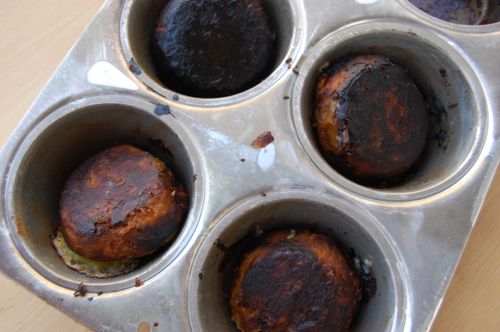The High Heat Myth: Busted
I think we can safely count the claim made by the proprietors of the Antiga Confeitaria de Belém bakery — that they bake pastéis de Belém at 750 degrees Fahrenheit — as a myth (of the intentionally created variety). Probably a diversionary tactic they use to discourage people from trying to make their pastéis at home.
I confess I had my doubts going into this. Elementary baking science dictates that extremely high heat is useless for everything from small tarts to Thanksgiving turkeys. Indeed, the larger and more massive the thing that goes into an oven, the lower the heat needs to be to cook it all the way through. The smaller the item, the higher the heat can be without risk of burning the exterior. Thus a 2-pound cornish hen can be roasted at 425 for 50 minutes, but a 15-pound turkey needs more like 350 and several hours. By that logic the only tart you could bake safely at 750 would be one the size of a dime, and you’d leave it in for 17 seconds.
Thursdays (unless I have pressing projects going) are bread baking days. I fire up the brick oven in the back yard and bake off ten or so loaves. Once the oven is fired and scooped out, it needs about 45 minutes to cool down from 700-something (its usual post-fire temperature) to around 600, the point at which I start loading. It’s the perfect window for a pastéis de Belém experiment.
Wanting to be conservative, I shaped four, poured in the custard mix, and slid the pan into the bricks. Then I set about getting my various accoutrements ready for the bread bake. Sure enough, not five minutes later I detected a whiff of burning pastry. I checked and saw bubbling filling and charring edges. I got out the laser thermometer and did a temperature check: 714 degrees. I decided to press on since the filling was still liquid. Five minutes later and the pastries, to put it in Scotty’s vernacular, could tak noo moore! Here’s how the tops looked:

Here’s what the bottoms were like.

And as for the interior, as expected, runny and raw.

I think we can declare this myth officially busted, as they like to say on the show. But I’m glad I tried, even if it was a sinful waste of good home made pastry.
Reminds me of a joke;
Two pastéis de Belém are baking in Joe’s brick oven.
The first pastéis de Belém says, “Dang, it’s HOT in here!”
The second one says, “Aahhhh! A talking pastéis de Belém!”
Now that’s a cracked sense of humor I can really appreciate. Thanks Dave!
– Joe
On the other hand, I cranked up my oven to the highest temp of 550, and I just couldn’t get the crust nice and golden when I tried making them, and I had pre-heated for an hour!
Interesting. I’ll definitely have more to say on heat when I put up the final tutorial. Thanks, P!
– Joe
Can’t argue with SCIENCE!
nice one, Joe 🙂
Hey, all I did was burn the things… 😉
Intriguingly, this phenomenon is directly attributable to the convergent corollaries of two scientific precepts: Newton’s Law of Heating and Thermokinetic conductivity. As indicated within Newton’s law (essentially constituting an instance of tangibly-applied integral calculus techniques), the rapidity of an entity’s alteration within temperature state is proportional to the thermal discrepancy existent between itself and the ambient realm. Consequently, immersion of the pastéis within a hotter oven context elevates the rate of surface cooking (an intuitive concept). However, although the external components of the pastéis elevate rapidly within such extreme thermal exposure, the relatively insulatory tendencies ascribed to puff pastry (and glutinous doughs in generality) impedes energy conduction to the encompassed protein filling, explicating the carbonized tart exteriors while central portions persist uncooked. (Your observation concerning correlations between baked good proportions and correspondent oven temperatures conforms to another mathematical law, but I will refrain from dominating this response section with esotericism)
Simply desired to furnish a degree of theoretical predication for the occurrence and expound upon this intriguing post! I veritably embrace your incorporation of scientific premises within the formulation and execution of baking processes!
-Scott
Scott, I thank you. As I say often, I really on people who really do know what they’re talking about to keep me on the straight and narrow! Though I phrased my delivery of the principles at work much more crudely than you just did, I’ve always believed that without at least a working knowledge of the science involved, aspiring bakers will never gain the confidence they need to improvise on their own. I appreciate you weighing in on this…feel free to do so as much as you like in the future!
Cheers and thanks,
– Joe
Do you think they might bake them in two stages? One stage at a lower heat to set the custard, and a second high heat stage to get the “brulee” effect on the top?
Funny you should say that, but I suspect the very same thing. I think the next time I do these I’ll finish them under a low broiler.
– Joe
I think if you do that the custard will curdle. It wants to be just set, not hot enough to boil.
At 720 degrees the custard boiled in less than two minutes. By that point the crust wasn’t even near being finished. I can’t see how the custard would ever have a chance to set at this heat.
– Joe
oh dear!